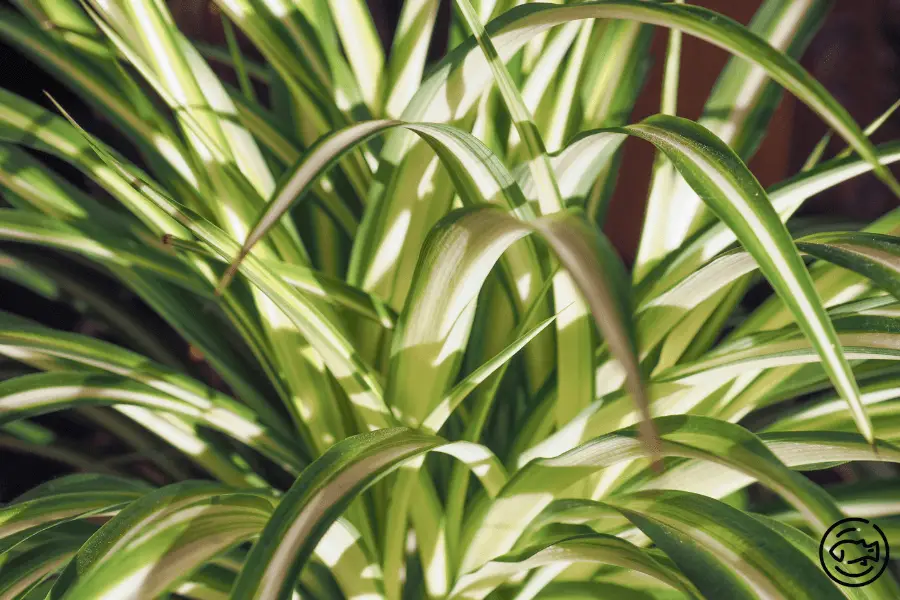The Aquarium Spider Plant is frequently referred to as the Spider Ivy Ribbon Plant, although its scientific nomenclature is Chlorophytum Comosum.
Its common identification is derived from its tendency to generate small offshoots on extended, cascading stems that look like spiders.
This plant extends stems of up to 2 feet in length, occasionally yielding a handful of miniature leaves.
Under promising circumstances, it may even flourish and blossom. Successful pollination results in the development of a capsule-like fruit that houses several flat, ebony seeds.
The spider plant is affiliated with the Asparagaceae Family, and this is a popular species arising from tropical and southern Africa.
Spider plants have also established themselves in their naturalized state in western Australia and Bangladesh.
Can You Grow A Spider Plant In Your Aquarium?

Is it possible to cultivate a Spider plant within your aquarium? The answer to this query is somewhat nuanced as it can be done, and also, it is a challenging task!
Spider plants are not suited for underwater existence. Consequently, if you immerse the plant entirely, its leaves will swiftly decay, leading to the demise of the plant.
Nonetheless, you can cultivate these non-aquatic specimens within your fish tank, granted that their foliage remains completely above the water’s surface. Notably, Spider plants do not necessitate soil for sustenance.
How To Properly Plant Spider Plants In Aquarium
To properly plant spider plants in aquaria, follow these four simple steps:
- Prepare the aquarium: Start by selecting a suitable-sized aquarium with sufficient lighting and a water temperature between 70-75°F. Ensure proper filtration and water quality to maintain a healthy environment for the plants.
- Choose the right substrate: Opt for a nutrient-rich substrate that promotes root growth and provides stability for the spider plants. Consider using a mix of aquarium soil and sand or gravel to create a balanced planting medium.
- Planting the spider plants: Carefully separate the offshoots or baby spider plants from the parent plant. Place them in the substrate, ensuring the roots are covered but the leaves remain above the surface. Space them evenly to allow for growth and prevent overcrowding.
- Maintain optimal conditions: Regularly monitor and maintain the water temperature, lighting, and nutrient levels in the aquarium. Spider plants prefer indirect light, so place the aquarium in a well-lit area away from direct sunlight. Ensure regular pruning to control plant growth and prevent overshadowing of other aquatic organisms.
Water Requirements
Aquarium Spider plants necessitate freshwater settings for their growth and cannot endure saline conditions.
Aqua environments incorporate a filtration mechanism that stirs the water’s surface, ensuring an ample supply of dissolved oxygen for the fish.
Plants in a tank can increase oxygen levels by consuming CO2 and releasing oxygen through photosynthesis.
Lighting Requirements
Aquarium Spider plants require moderate lighting for growth, with some tolerance for shade.
Spider plants are known to flourish more effectively when placed in fish tanks with medium to low levels of artificial lighting. This is in contrast to placing them on windowsills that are directly exposed to sunlight.
The controlled lighting environment provided by fish tanks allows spider plants to grow optimally without being subjected to excessive heat and light. This ultimately promotes their health and longevity, making them a great addition to any indoor space.
also read: Planted Aquarium Lighting – An Illuminating Guide
Temperature Requirements
Aquarium spider plants are highly adaptable and can thrive in temperatures ranging from 65°F to 90°F.
Hence, cultivating a spider plant on the surface of a coldwater aquarium should pose minimal challenges, and the humidity levels of a tropical tank align well with the needs of this plant species.
Fertilizers
Aquariums come furnished with a filtration mechanism that maintains water purity and manages compounds like ammonia, nitrites, and nitrates.
These substances come from the decay of fish waste, leftover food, and other organic matter. Nitrates pose significant harm to fish and possess the potential to prove lethal unless the hazardous compounds are eliminated from the water.
Nonetheless, aquatic flora harnesses these elements as nutrients.
Certain enthusiasts, particularly those with abundant aquatic greenery, opt to complement this process by employing root tabs or liquid fertilizers.
Pesticides
While spider plants pose no toxicity risk to fish, a significant number are cultivated in commercial horticultural greenhouses, where they undergo treatment with insecticides and pesticides.
These chemical agents can prove lethal to your fish and other aquatic livestock. Therefore, if you opt to incorporate a spider plant into your aquarium, it is advisable to verify with your supplier that the plant is free from any residues of pesticides or other chemicals.
The Benefits Of Having Spider Plants In Your Aquarium
Incorporating spider plants into your aquarium can be highly beneficial for aquatic health. These plants provide several significant advantages:
- Enhanced Water Quality: Spider plants are known for their unique ability to sift nitrates and other toxic substances from water, making them of higher quality. By doing so, they can help maintain optimal water requirements, minimizing the possibility of algae growth and furnishing a more nourishing environment for your aquatic friends.
- Oxygenation and Carbon Dioxide Absorption: Spider plants are known for their excellent ability to produce oxygen through photosynthesis, helping to enrich the oxygen levels in your aquarium. Simultaneously, they absorb carbon dioxide, a byproduct of respiration, in the tank, providing a balanced ecosystem for all the inhabitants.
- Aesthetic Appeal and Natural Habitat: Adding spider plants to your aquarium not only enhances the visual appeal but also provides a natural habitat for your aquatic pets. The lush green foliage of these plants creates a naturalistic environment, offering hiding spots and shelter for small fish or shrimp, reducing stress and promoting their well-being.
FAQs About Aquarium Spider Plant
Can you grow a spider plant in a fish tank?
Yes, you can grow a spider plant in a fish tank as long as the foliage remains above the water level.
What conditions are necessary for a spider plant to grow in an aquarium?
A spider plant in an aquarium needs freshwater, moderate lighting, proper filtration, and nutrients for photosynthesis.
Can spider plants survive in saltwater?
No, spider plants cannot survive in saltwater and should only be grown in freshwater aquariums.
Is it necessary to use fertilizers for spider plants in fish tanks?
Spider plants can benefit from the natural fertilizers produced by the fish excrement in the tank. However, some hobbyists choose to supplement with root tabs or liquid fertilizer.
How should I plant a spider plant in my fish tank?
The best method is to float the plant directly in the water, ensuring that the roots are covered while the leaves remain above the waterline.
Conclusion
Did you find our post on cultivating Spider plants in your aquarium enjoyable?
If so, kindly share the article before departing.
Aquarium Spider plants are a prevalent indoor plant that graces many households.
However, it’s possible to cultivate this plant within your fish tank as long as you ensure that the Spider plant’s foliage remains entirely above the water’s surface.
This is a robust plant capable of withstanding a broad spectrum of conditions and temperatures. It thrives in aquatic environments, deriving nutrients from your aquarium water.



